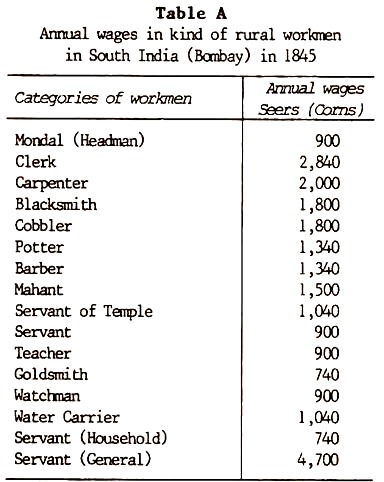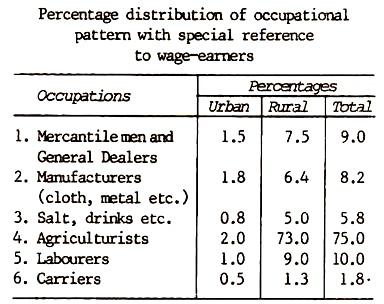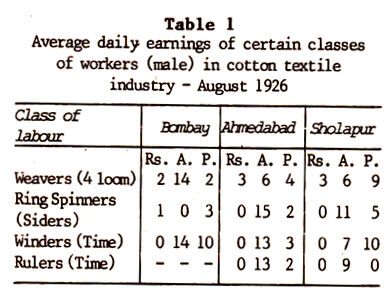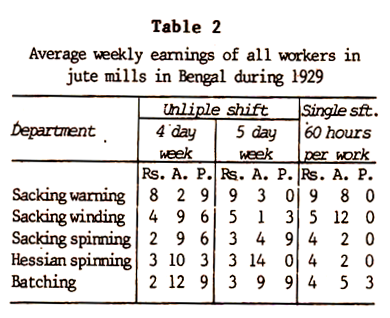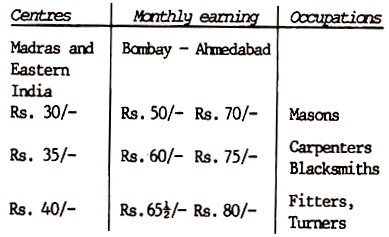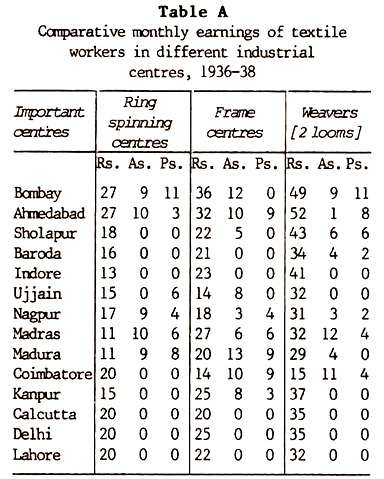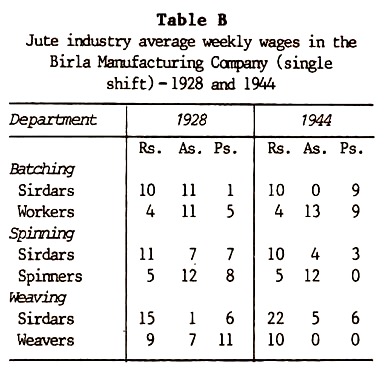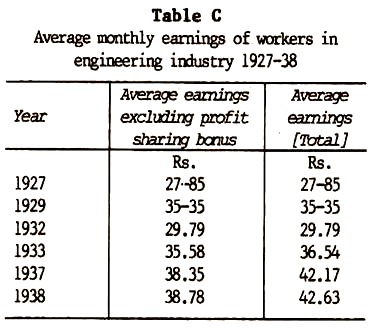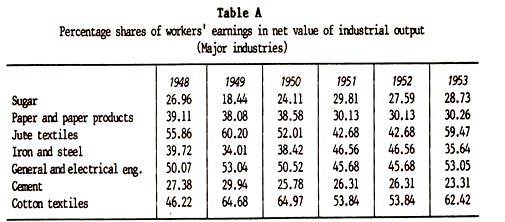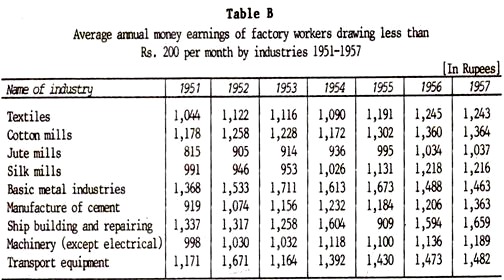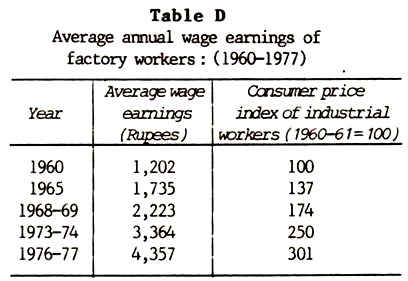In this essay we will discuss about the classification of wage trend in India.
Classification of Wage Trend in India:
- Essay on the Wage Trend in Working Class and Wages in Ancient India –Hindu Period
- Essay on the Wage Trend in Medieval India –Muslim Period (1194-1707)
- Essay on the Wage Trend in British India-(1707-1946)
- Essay on the Wage Trend in Post-War Period in India
- Essay on the Wage Trend in Some Key Industries (1930-1946) – Modern Period
- Essay on the Wage Trend in Post-Independent Period (1947-1977)
Essay # 1. Wage Trend in Working Class and Wages in Ancient India –Hindu Period:
2500 BC – 1194 A.D. pre-Vedic and Vedic age:
The origin and decline of wage conditions in ancient India is the history of rise and fall of Hindu civilisation. About 5000 years ago, when Indus Valley Civilisation began to grow up, artisans of various categories i.e., silk weavers, melters, village craftsmen etc. worked and produced their own products and formed self-employed guilds.
During this period these guilds paid wages in kind to the craftsmen and artisans. As industrial civilisation of the modern type was unknown, the wages were paid as comparable with agricultural labours based on agrarian system.
During pre-Vedic and Vedic age, especially during Rig-Vedas and till the days of Mahabharata and Ramayana, wages were paid to the artisans and craftsmen in kind by the local kings or the village guilds. Money wages in the form of the present day practice was quite unknown until money was invented as a medium of exchange. A sort of barter system prevailed during the period of Mahabharata.
Reference of Wages in Shukra Nitisara Kautilya’s Arthashastra, Mahabharata and Jataka:
Probably, the first authoritative reference to wages one might get in ancient India is from Kautilya’s “Arthashastra” and “Nitisara” by Shukracharya. During the tenth century A.D., “Nitisara” gave a description of Indian polity, especially organisation of the Central Government, town and village life, particularly the village panchayat.
The panchayat members were elected and had executive-judicial powers who collected taxes, distributed land, paid wages to the workers and also paid the governments’ share on behalf of the village.
During this period, according to Nitisara, in larger towns there were varieties of artisans, merchants; craft guilds, merchantile associations and Banking Corporation, and each of them had its own wage payment systems.
The information relating to wages was, however, fragmentary in “Nitisara”. But it was evident from other sources like inscriptions, that the system of self-government in towns and villages was very strong and effective; and the kings and their council of ministers of the top seldom interfered with economic and social activities of the elected bodies.
Originally, the agrarian system was based on cooperative on collective village. And the determination of wages, fixation and actual payment of wages were all done by the self-government panchayats on the basis of customary law.
As there was no theocratic monarchy during the Vedic age in India, the king only had the right to collect certain revenues from the land, and thus revenue-collecting power was delegated to samantas and others who owed allegiance to the king.
The peasants, artisans and craftsmen were not subjected to landlord system, but were paid their wages by the local elected bodies, as noted already. This economic system continued also in Muslim Period, which was disrupted by the British landlord and provincial system resulting in ruination and exploitation of the prosperous village skilled workers.
Kautilya’s Arthashastra:
During the fourth century B.C. Kautilya’s Arthashastra gave us more details about the statecraft and polity of ancient India which was principally an agricultural civilisation based on village self-government.
Notwithstanding basic emphasis on land and matters relating to land, there were a good number of crafts manufacturers and workers engaged in various occupations. These were mainly in mining for metals and precious stones. Workers were also employed in manufacturing goods like silks, woolens, cotton, tea, tiles, rugs, blankets and carpets.
Spinning, weaving and dyeing were also flourishing industries. The workers employed in the metallurgical industry produced weapons of war. The workers in building industries using stone, wood and bricks, and carpenters making carts, chariots, ships, bedsteads, chairs, chests, toys etc. earned higher wages in the society.
There were also a good number of cane-workers who made mattresses, baskets, and fans, and workers engaged in making perfumes, oils, sandalwood, medicines, drugs. Besides, a lumber of professional classes like teachers, physicians, surgeons, merchants, traders, musicians and actors were highly paid.
According to the Jatakas, ancient India, even before 4th century B.C. appeared to be a highly civilized society where trade associations, craft guilds and trade unions were formed to safeguard the interest of all types of workers of different skills.
In ancient India, a very important and sophisticated development took place in the shape of settlements of villagers of people belonging to particular crafts, like carpenters’ villages, smiths’ village etc. Domestic slaves appeared to exist who were not paid any wages. Agricultural and other unskilled workers were treated as hired labour and some classes of labour doing unclean jobs were treated as untouchables.
According to Washburn, a noted Indologist, the existence of trade associations which grew partly for economical reasons, like better employment of capital, facilities of intercourse, and partly for protecting the legal interest of their class, is surely to be traced to an early period of Indian culture.
According to the Jatakas, there were eighteen craft unions of which four were very strong, i.e., the wood working masons, smiths, leather workers and painters. According to the Mahabharata, “the safe-guard of corporations (guilds) is union”, “the merchant-guilds were of such authority that the king was not allowed to establish any laws repugnant to these trade unions”.
The heads of guilds were mentioned next after priests.
Essay # 2.
Wage Trend in Medieval India –Muslim Period (1194-1707):
On the eve of Muslim invasion in 1194, the vast majority of population in India consisted of agriculturists. But there was no landlord system, nor was there any peasant proprietorship. It was difficult to unearth the mystery of ownership of land and the fixation of wages.
The rigid Hindu caste-system gave rise to the vast army of untouchables who joined the rank of landless agricultural labour. Early in the eighth century, in 712, the Arabs occupied Sind and in about 1000, Sultan Mahmud of Ghazni of Afghanistan invaded India.
This invasion was followed by repeated Muslim incursions from 1194 which annexed Punjab and many parts of North India, till Babar established the foundation of Moghul Empire firmly in 1526. During 1526-1707 Moghul Empire flourished and at the end, when the Moghul Empire after the death of Aurangzeb crumbled, the East India Company was granted trading permission in 1615.
Reference of Conditions of Craftsmen in Babar’s Autobiography, Alberuni, Marco Polo and Aaain E Akbari: Working Conditions of Artisans on the Eve of the Breakdown of Moghul Empire and British Invasion:
After the decline of golden era of Gupta Civilisation, the prosperity of Hindu period also began to fall. During 11th to 16th century, in the medieval period of Muslim rule, artisans, skilled workers and craftsmen began to lose much of their skill because of foreign invasion, disintegration of religions, political and military powers.
Prior to Babar, Muslim invaders forced large number of skilled workers, artisans and craftsmen to leave India under duress and used them in building palaces, making luxury goods in Afghanistan, Persia and in Central Asia. Reference of wage conditions during the medieval period of Muslim rule appeared to be scanty and insignificant because of paucity of reliable sources.
According to Babar’s autobiography, after Taimur Leng’s destruction and carnage of Delhi, cultural degradation had descended on North India. This resulted in exodus of skilled workmen, craftsmen and artisans to South India. Wages also began to fall and Babar found falling standard of skill and ingenuity of workmen and lack of mechanical invention.
As compared with Iran, the standard of living of the people of Hindustan was lower. But in South India, during this period, Vijayanagar and Bahamani Kingdom excelled in higher standard of living and luxury. Probably Afghan and Moghul invasion in India brought about a degeneration and decaying cultural change which adversely affected wage conditions during Babar’s period.
During the 11th century A.D., Alberuni, the famous Persian scholar and traveller, came to India and learnt Sanskrit for studying Indian philosophy. According to his accounts, ordinary working class people enjoyed lower standard of living and poor earnings, whereas those craftsmen who enjoyed Sultan Mahmud’s (Ghazni) patronage earned much higher incomes.
It was quite likely that some forms of wage-differentials existed during this period. Alberuni thought the working class people were proud and haughty despite their falling standard of skill.
Marco Polo, the world famous traveller came to South India, in Madura twice, in 1288 and in 1293, on his way from China. He described Madura and the adjacent port as a great and noble city full of ships from Arabia and China. He particularly mentioned shipping and silk industry as the finest in the world.
The weavers produced very fine muslins which “look like tissues of a spider’s web” and their wages were the highest among artisans. Marco Polo also referred to horse trading (importing) as very important business where a good number of workers were engaged, but their wages were lower as they were mostly unskilled.
Abul Fazal, during Akbari regime, the famous author of Aaain-E-Akbari and “Akbar-nama” had given accounts of economic, political and cultural conditions of the people of medieval India. Throughout the Moghul period, India had intimate contracts with Central Asia including Russia.
A good number of traders and craftsmen established trade mission and settled in Moscow in 1532 through Khoja Hossain, an envoy of Emperor Babar.
In 1625, a large number of craftsmen and weavers were invited in Moscow. During the reign of Jehangir, tobacco was imported from America. In 1695 and in 1722 trade contacts were established between Russia (in Astrakhan) and Delhi. This followed considerable improvement and economic regeneration of large number of craftsmen, especially weavers, who enjoyed higher earnings.
Akbar did not interfere with social and cultural life of ordinary people and this enlightened attitude greatly improved the skill, wages and working conditions of the artisans and craftsmen. After the fall of Moghul Empire, the British thoroughly de-generated the life-style of the craftsmen and artisans and Indian craftsmen were forced to become agricultural labourers.
Economic conditions of craftsmen during Muslim period, however, continued to deteriorate further after the death of Akbar. Historically, Muslim rule brought about significant cultural changes in Hindu-Muslim relationship which vastly affected the wages and economic conditions of craftsmen and artisans.
Muslim invasions and long period of Muslim rule, particularly on the eve of breakdown of Moghul Empire, led to large-scale conversions of low caste Hindus into Muslims, especially in Bengal. These converts mostly become peasants, artisans and craftsmen.
Some of the important occupations like weavers, shoe-makers, tailors, masons, were mostly Muslim during Muslim rule who enjoyed the patronage of the ruling class and, therefore, higher earnings.
The destruction of crafts and village industries originally deliberately undertaken under early British rule and later resulting from the development of a new colonial economy led to vast numbers of these artisans and craftsmen, more especially the weavers, being deprived of their occupations and livelihood. Those who survived this catastrophe drifted to the land and became landless labourers.
Muslims who came to India from outside brought no new technique or political or economic structure, who were mostly class-bound and feudal in outlook with inferior production and industrial organisation.
Thus their influence which the craftsmen inherited as a cultural legacy continued to prevail during the transition period of Moghul and British invasion. This contributed substantially to the stagnation and degeneration of industrial culture of working class people on the eve of British invasion.
During Jahangir’s reign British naval power was fast rising and in 1615, Sir Thomas Roe, an ambassador of King James I of England, succeeded in obtaining permission to start factories in India. A factory was started in Surat and Madras was founded in 1639.
For over the next hundred years British trading adventure was slowly and steadily assuming political and military character and finally the East India Company set its political foothold in Bengal firmly when the battle of Plassey (1757) paved the way of British rule in India.
During the last days of the Moghul Empire, when the economic structure of India was cracking, there were repeated uprisings of the peasantry. From 1669 onwards, the Jat peasants near Delhi revolted, and then there was “Satnami revolt” which was described by a Moghul noble as, “a gang of bloody miserable rebels, goldsmiths, carpenters, sweepers, tanners and other ignorable beings.”
This clearly proved to what extent the plight of the working class people degenerated. The entire economic, political and social edifice of Indian Society and the fabrics of cultural life of the poorer class of people, both Hindus and Muslims, were fast crumbling.
The wages and livelihood became too low and scarce, and in the absence of any industrialist class, the industrial structure, whatever remained, became an easy prey to the British intruders.
After the death of Aurungzeb in 1707, for the next 100 years a complicated and many-sided struggle for mastery over India began as between the Marathas, Sikhs, princely overlords, the British, French and Portuguese. Thus the story of the Indian working-class people and wage-conditions since ancient period was largely the history of India’s political and military watersheds and landmarks.
Essay # 3.
Wage Trend in British India (1707-1946):
Profile of a Dependent Colonial Economy A Case-study of Bengal (1650-1859):
The origin and evolution of wages in British India may be best understood with reference to Bengal as a case-study, where the process of indigenous industrial ruination was first initiated and then, subsequently, colonial industrial system was firmly established by the British. East India Company established its first trading foothold in Bengal at Hugli in 1650.
The Company then moved to Calcutta in 1690 and established its both trading and military base. In 1717, the company obtained a Farman from the disintegrating Moghul Court exempting its incoming and outgoing merchandise from customs in consideration of a lumpsum payment of Rs. 3,000 per year.
After the battle of Plassey (1757) in Bengal, when Nwabab Serajiddaula was defeated by the British and assassinated in conspiracy with Mir Zafar, the Dewanis of Bengal was granted to the British in 1765.
Soon after the battle of Plassey, the process of exploitation and ruination of Indian industries and crafts was started with unabashed ruthlessness, first, in Bengal, then extended gradually to the entire sub-continent in entire eastern and northern India.
Romesh C. Dutta, the famous historian writing on Indian economy during this period observed, “The people of Bengal…. had been used to arbitrary acts from men in power, but had never suffered from a system which touched their trades, their occupations, their lives so closely. The springs of their industry were stopped, the sources of their wealth dried up”.
The East India Company embarked on, with ruthless force, an economic policy to monopolise manufacture, particularly of silk, cotton fabrics, by forcing craftsmen to work in its factories or to work at home committing to buy raw materials from it and to sell the finished articles to it.
This process of oppression and exploitation had been narrated by Mir Qasim when he wrote to the company in 1762 (Mir Qasim was subsequently deposed by the company forcibly) –
“The (Company’s servants) forcibly take away the goods and commodities of the ryots, merchants etc. for a fourth part of their value and by ways of violence and oppression they obliged the Ryots to give five Rupees for goods which are worth but one Rupee”.
According to an English merchant in 1772, which corroborated the process of exploitation, the weavers were made to sign contracts, and tied in their girdles and flogged. After the industrial revolution in Britain, machine-made British goods were started to be imported and Indian raw materials exported both duty-free, killing Indian industries and crafts.
In course of five decades from Plassey, all industries in Bengal declined cotton and silk spinning and weaving, sugar, salt, iron- smelting, tool-making, dyes and ship-building.
Innumerable number of craftsmen, who had acquired skills in different trades over many generations, became jobless and over-crowed in agriculture as labourers. Their wages were fixed arbitrarily without any principles, often nearing serfdom. Gradually, Bengal and other industrial centres in India became victims to British exploitation in this process.
In 1779, the process of forced ruralisation assumed a new dimension when British planters started indigo planting by forcing farmers to take to indigo cultivation and to give up cultivation of food crops.
For full eighty years this oppression continued with crude force, when in 1859, the indigo revolt broke out dramatizing the events into the in-mortal drama “Nil Darpan” by Dinabandhu Mitra. Subsequently, indigo cultivation declined when chemical dye became commercially profitable.
The British Colonial Government also turned to jute and tea in Bengal and Assam, and to cotton in Bombay and South India for serving the interest of British manufacturers and traders. During 1870-76, Dadabhai Naoroji made a thorough study of the then economic conditions of India and gave the following analysis on wages.
He prepared the method of taking into account the number of labourers who earned each rate of wages and the number of days on which such wages were earned during the year.
As regards wages of unskilled labour, he had surveyed the contemporary available statistics and found considerable regional variations due to several factors like distribution of public works projects, favourable conditions in provinces like Punjab, famines and scarcity, regional distribution of remunerative commercial crops such as poppy, indigo and cotton.
The rates of wages varying between 2 and 5 annas per day were averages “without any reference to the number of persons earning the different rates of wages”. Along with these factors, he believed that number of days of employment in the year and the temporary nature of job in public work projects had to be taken into consideration for ascertaining the rates of wages.
He contended that calculation of average rates of wages of unskilled labourers who constituted the vast mass of working class people was a crude and artificial one, and concluded that “notion of a general rise of wages and the vastly improved condition of labourer is a delusion”.
During the middle of the nineteenth century, in South India, as Table-A would indicate, these categories of community (rural) workmen were paid in kind from the allocation of corns which were distributed as wages according to apportioned shares of the total land rent (in kind) collective from the village rural cultivators.
Gradually land revenues began to be collected in cash during the latter part of Muslim and earlier British rule. Especially, from permanent settlement system, the village community wage payment system began to decline and the Zamindars appropriated all the shares of the aforesaid rural workmen reducing these classes to paupers.
Even in 1845, in certain rural areas of South India, the above classes enjoyed some assured security and regularity of earnings. But gradually, the British industrialists set up factories in city areas. The rural workmen left the villages to join the factory as industrial workers. All this process gave rise to the decline of the village community workmen and the emergence of industrial working class.
As a matter of fact, during this period, real wages declined, even if labourers were paid in kind, remaining money wages fixed; and where labourers were paid cash, real wages were reduced due to rise of food prices and recurrent famines.
Romesh Chandra Dutt also surveyed historically India’s industrial decline during this period in his famous works. While Dadabhai built drain theory as “internal economic exploitation” by the British, Dutt conceptualized “external economic drain” by his emphasis on evils of excessive land tax as a political counterpart of British imperialism.
He pointed out that contemporary per capita income of an Indian was 2, contrasted with 48 in Canada and other colonies and found 42 in Great Britain, and contended that low level wages and lack of purchasing power were the real causes of recurrent famines and not the scarcity of food as such.
In fact, British ruling class during this period believed in the logic of keeping labouring class on a subsistence minimum by heavy taxation according to Iron Law of Wages.
During the upsurge of Swadeshi movement, between 1864-1930, a number of Indian scientists and technicians attempted to analyse the bright prospects of skilled workers who may be trained to be absorbed in such industries like dyeing, tannery, sugar refining, soap making, ceramics, mining and electro-engineering.
During the latter part of the 19th century British regime in India, the first significant reference to the analysis and thinking on wages and conditions of working people was found in Raja Ram Mohun Roy’s writings in 1831.
Ram Mohun was contemporary of Malthus, and, therefore, influence of Malthusian theory of population was great in British India. Ram Mohun wrote in 1831, “Does the population increase rapidly in India? It does increase considerably from the early marriage of the people, and from the males so seldom leaving their families.”
Ram Mohun believed in Malthusian theory of population, and in this connection, he referred to “the occasional positive checks to this superabundance” referring mainly to dreadful occasional famines and epidemics like cholera, which “greatly reduced the surplus population, and the condition of labourers has since been greatly improved in comparison with what it was before the people were thinned by this melancholy scourge”.
During Ram Mohun’s period, despite positive checks, population was increasing and the rural poverty was very well-marked. But, according to Ram Mohun, “the population is so unequally distributed” that “there is a general impression of an undue increase in population”.
However, the conditions of rural labour and wages prevailing during 1879 were analysed with considerable sophistication and insight by Bankim Chandra Chatterjee. He analysed a link between Malthus and James Stewart Mill by examining the relationship between Malthusian population theory and the classical wage fund theory.
According to Bankim Chandra, the growth of social wealth was divided into two shares:
(a) Wages of manual labour and
(b) Incomes of intellectual labour which he called “profit”.
Wage-earners never received any share of profits, only wages. Thus, whatever accrued as wages would be divided amongst the labourers, irrespective of their numbers.
If the “fund” available for wages increased, as the result of increase of wealth, and if population did not increase more than in proportion, the working class would be able to maintain its standard of living. If population exceeded the social wealth, a decline in wages and standard of living of labour would ensue.
On the basis of the above reasoning, Bankim Chandra showed that, during his period in British India, wages began to decline due to increase in population and exploitation of social wealth by the British.
Referring to Indian conditions during this time in this connection, Adam Smith in his famous, “The Wealth of Nations” wrote:
“The demand for those who live by wages cannot increase but in proportion to the increase of the funds which are declined to the payment of wages… the demand necessarily increases with the increase of the revenue and stock of every country, and cannot possibly increase without it”.
Bankim Chandra advocated several measures to counteract the depressing effects of population on wages of Indian labouring class:
(a) Emigration
(b) Restriction of marriage.
But in India, during that time, due to comparative case of supporting life and absence of complexity of society, these measures could not be adopted. Thus, gradually in consequence, misery of manual labourer hastened with declining standard of living which was caught in a vicious circle.
Analysing Indian conditions of labour and wages during the period, observations of two important authors are worth noting: According to G. V. Joshi, the basic problem in British India was not overpopulation but under-production due to the process of exploitation by the British rule resulting in falling wages.
Joshi observed:
“When population multiplies at an abnormal rate, while production keeps up its normal level, there is, properly speaking, the evil of overpopulation. But when production falls off, while population is advancing at its normal rate, we have what we may call the evil of under-production. The capitalist political economy, looking only to one tern of the ratio, confounds the two evils—in their nature so different—and styles them as overpopulation in either case”
It is evident that educated Indians were averse to Ricardian theory of rent and Malthusian theory of population. But, in Indian context, the main assumptions of Ricardian theory of rent which had bearing on price and wages that perfect competition in market and perfect mobility of factors of production were not found to be valid.
But, Ricardian theory, in fact, is not peculiar to land only; it is applicable to any factor of production which has producer’s surplus.
In this connection, it is worth quoting Ranade, the famous Indian pioneer economist who observed, “The Ricardian theory that economic rent does not enter as an element of price, admittedly does not apply when all occupied land has to pay monopoly rent to the state landlord. There is no competition among landlords in this country, for there is one, time landlord, and the so called land tax, which is not a tax on rents proper, but frequently encroaches upon the profits and wages of the poor peasants.”
The great Indian economist Dadabhai Naoroji, the author of the famous “Drain Theory”, also refuted overpopulation theory when he observed: … To employ industry to land is to apply capital to land. Industry cannot be employed to any greater extent than there is capital to invest. There can be no more industry than is supplied by materials to work and food to eat.
Obviously, this observation implicitly had reference to wage-fund theory under the then Indian economic system which would have brought into employment labour required to produce wage goods, capital goods and final commodities.
During this period, continuing process of exploitation and drain of Indian resources to sustain British cotton industry in Lancashire resulted in ever-increasing taxation, high prices and falling wages both in terms of money wages and real wages in jute, textile, and plantation and in almost every craft and cottage industries in India.
The rise in the level of taxation in India between 1882-1895 was 35 per cent as compared with only 14 per cent in Great Britain.
According to Joshi, “neither rents, nor profits, nor wages, nor prices were appreciably influenced by the Govts taxation policy which was all dwindling”. On the basis of contemporary census statistics, the following occupational distribution pattern was found which will give an idea about the wage earners.
Government service and professionals 3.7 percent; domestic service 3.1 per cent; agriculture 65 per cent; labourers 9 per cent. Famine Commission reporting earlier than 1881 census in this connection, observed:
“Many artisans and professionals, besides their trade, own and cultivate land and must be added to the population that lived on land”. This implies that taking direct and indirect percentage of population connected with land, the total population percentage depending on land must be about 80 per cent.
The following Table would indicate the contemporary occupational structures (both urban and rural).
Percentage distribution of occupational pattern with special reference to wage-earners
It will be evident from the Table that during the period, occupational pattern was a mixed one. Manufacturers and other craftsmen were not wholly occupied with their jobs throughout the year; carriers and labourers formed a single category.
Carriers include casual labourers like towing crew, palanquin bearers, dark runners, cart drivers etc. These carriers were landless unskilled manual workers as well as regular farmers with small holdings. This working class formed a floating mass and their wages were quite low.
The entire working class was subjected to severe rural under-employment and chronic unemployment cycles caused by severe famines and epidemics. In fact, the contemporary India was a colonial dependent economy mainly converted into agricultural society.
During 1882-1895, British industrial enterprises, new railway system and free trade doctrine were steadily cheapening labour by throwing out of work whole classes and completing the ruin of India’s traditional industries like tanneries, woolen mills and pottery works.
Due to cunning and discriminatory business policy pursued by British entrepreneurs, India’s traditional urban industries began to perish as a result of “foreign competition” from without and rural industries were dying as a result of “foreign competition” from within.
The net result was the emergence of a new industrial society in India during the latter part of the nineteenth century in which the Indian industrial worker was reduced to the servile with no other return but cheap wages fixed arbitrarily while skill, profits and intelligence were all monopolized by British entrepreneurs.
Gopal Krishna Gokhale, the noted Indian nationalist leader, analysed Indian working class conditions, wages and problems of industrial development with remarkable foresight during 1900-1915 in his famous lectures and writings Gokhale attributed the several factors to India’s “deep and Deeping” poverty which, again, he described as factors that might increase real income over time, viz.,
(i) Increase in the labour force
(ii) Increase in foreign trade
(iii) Increase in the proportion of men and women engaged in production
(iv) Capital investment for higher productivity of labour
(v) Increasing skill formation
(vi) Shift from less productive to more productive occupations.
Gokhale traced Indian industrial stagnation and backwardness since British occupation to converting India by the British as supplier of raw materials and food to England. He sought to link Dadabhai Naoroji’s “drain theory” with a development theory from the viewpoint of welfare of the India’s toiling masses of the rural population.
According to him, during this time, next to agriculture, cotton industry was the largest industry accounting for a paid capital of Rs. 17 crores, 200 mills with 5 million spindles and 50,000 looms, consuming 60 per cent Indian raw cotton and producing 58 lbs. of yarn, according to the Census of Manufacturers 1901.
Indian cotton mill industry, the handloom sector, provided employment to about a quarter of million persons. Portraying the sordid conditions of the contemporary wage-earners, Gokhale observed:
“Our poorer classes contribute, relative to their resources, much more than their fair share to the revenues of the state. These classes included normally the tillers of the soil, but also the great class of day labourers and the least skilled of the artisans. Barring probably the weavers, mill hands, factory workers and certain classes of small artisans, this unskilled labouring class had been subjected to the precipice of famines and indebtedness.” This observation was also corroborated by the Famine Commission 1898.
Probably, Gokhale was the first among the then leaders to visualize India as a welfare state, in which social security for the underprivileged would be provided in adequate measures. He also raised his voice against the “bonded labour system”, under which ignorant Indian villagers were recruited under indenture to serve in unknown and distant places of plantations of unknown employers.
They were not allowed to leave their employers except under permits which were not easily granted. During this period, they had to work for wages which were lower than the wages of free labour and were subject to special law (not understood by bonded labour) which made them criminally liable for most trivial “breaches of the contract”. This class of labour was ultimately reduced to perpetual serfdom by means of repeated indenture.
Gokhale also took up the cause of protection of child labour in factories. In those days, under the “split shift” system, in Indian factories, children’s working days used to be split between the morning and the afternoon, but they had to be present in, or near, the factory premises for longer hours than their working periods.
When they were idle or sick, neither employers nor their parents took any care of them. Gokhale advocated suitable legislation or proper responsibility by factory owners for child labour’s education and protection on broad grounds of justice and humanity.
It would appear remarkable how Gokhale stood as a veritable bridge between 19th century and modern 20th century Indian economy in his economic thinking especially relating to economic conditions of the working-class people.
During Swadeshi movement, especially in 1930, as is well-known, Mahatma Gandhi spearheaded village Khadi Movement as economic counterpart of political movement for India’s emancipation. Gandhiji reinterpreted Swadeshi as revival and development of rural handicrafts and small industries out of which he gave importance to hand spinning and hand weaving.
In this connection, he also observed:
“The urbanisation of tanning industry can do little good to the Harijans. It is a process of double drain from the villages, to remove from the villages rural industries are to remove what little opportunity there is for making skilled use of the hand and the head.”
In respect of the handloom sector, he pointed out two defects:
(1) The low wages of spinners and
(2) The bad quality of production.
He said, “There was no question of deliberate injustice. Work was to be found for the workless who were too many. But the cut-throat competition from mill-made cloth was leading to the price cutting of Khadi. Wages are low in consequence. If wages were raised, or rigid quality tests enforced, the resulting high prices of Khadi would lower the demand.”
On the question of minimum and fair wages during this period of Great Depression, he said “You will have to determine a point beyond which you cannot go in the matter of giving work to people. If a minimum wage has to be fixed, why not fix it once and for all, no matter whether it affects some of the producers for the time being adversely? …. Why not have deliberately fixed high minimum wages, to ensure these poor men and women at least a minimum wage? …. The mill cloth producer will always concentrate on cheapening production. We must concentrate on justice and fair wages.”
In this connection, he warned against mass production of key industrial consumer goods, which had always severe repercussions on wage earners.
Gandhiji conceived of a system of “rural communitarianism” based on co-operation and by this he advocated a sort of labour power for community service. Jawaharlal Nehru, in his “Discovery of India” referred to this approach of Gandhi as self-contained Indian type of rural socialism different from Marxian Communism.
After independence, Nehru’s emphasis on big industry and the subsequent Five-year Plans, however, made a drift from Gandhi’s economic concept of rural socialism, and, it is debatable, how far Gandhian approach could solve the wage conditions of wage earners in India.
Essay # 4.
Wage Trend in Post-War Period in India:
A Study of the Report of Royal Commission on Labour 1931:
The Industrial Commission, 1918, gave the general description of contemporary industries in India at the end of the First World War. The Royal Commission on labour was appointed to examine and analyse wage levels in some of the leading branches of the cotton textile industry, jute industry, metal and engineering industries, mines, docks, since 1920. The commission submitted its report in 1931.
After the First World War (1914-1918) there had been sharp rises in price levels which necessitated rise in wage-levels of the above- mentioned industries. But this wage rise could not match post-war inflationary price-rise and, by 1920, the real wages were lower than pre-war level despite wage-rise.
But by 1923, post-war inflation was followed by recessionary trends giving rise to improvement of real wages as consumer price index was falling. But this phenomenon proved short-lived, a very common characteristic of business cycles.
The following tables as per the Royal Commission will give an idea about the contemporary wage-levels in cotton textile industry and jute industry.
Average daily earnings of certain classes of workers (male) in cotton textile industry – August 1926
Analysing the wage-levels in Engineering and Metal industries, the Commission found no uniformity in the wage-levels.
The variety of occupations and the great differences in skill were reflected in the wide variations of rates and earnings. Taking five typical occupations masons, carpenters, blacksmiths, fitters and turners the earnings of these were highest in Bombay and Ahmedabad and lowest in Madras, Bengal, Bihar and Orissa.
The following description will give an idea of the wage-levels:
Regarding wage levels of mines and dock labourers, the Commission could not analyse in details for lack of standard data. But, by and large, it was found that average monthly earnings of a coal cutter were between Rs. 10/— and Rs. 15/-.
Daily wages of dock labourers in Bombay varied between Arras 14/- to Rs. 1-8-0, in Karachi, it was Rs. 1-2-0, and in Calcutta the average monthly earnings were estimated to be about Rs. 20/-.
Wage levels of unskilled workers were the lowest which varied from province to province and within districts.
The unskilled labourers comprised of two categories:
(i) Manual labourers engaged in factories and other establishments earning more than Rs. 10/- per month minimum and Rs. 20/- maximum,
(ii) Labourers engaged in various miscellaneous occupations on daily rates casually or regularly; their rates were largely influenced by neighbouring agricultural labourers’ rates which varied from province to province and even within districts.
Regarding family income and standard of living, the Commission found it difficult to compile reliable data. This problem was particularly prevalent during this period amongst unskilled workers.
To maintain a given standard of living higher than subsistence level, it was felt necessary to earn by more than one wage earner in a family which was not possible in most of the families. Besides, expenditure pattern on necessaries of life, health and education, indebtedness etc. also greatly affected standard of living.
Recommendations of the Commission:
The Commission, while investigating the wage levels in key industries, came to the conclusion that several steps should be taken to improve standard of living of workers who were suffering from grinding poverty resulting in low efficiency due, to ill-health, lack of education and other comforts of life. In fact, poverty, efficiency and quality of Indian workers were caught in a vicious circle.
The Commission made the following recommendations for improving standard of living of workers:
(1) Raising wages on the basis of cost of living index and profit sharing
(2) Regularity of employment
(3) Ensuring minimum wages
(4) Accelerating the prosperity of industry and community
(5) Standardisation of wage rates
(6) Prohibition and regulation of deductions from wages and fines.
The Commission made detailed recommendation regarding fixation and enforcement of minimum wages in selected industries. This approach could be considered as the precursor that paved the way for- Minimum Wages Act, 1948, after Independence.
Essay # 5.
Wage Trend in Some Key Industries (1930-1946) – Modern Period:
Assessment of Wages by Labour Investigation Committee (Rege Committee – Main Report) 1946:
Since the publication of the Royal Commission report in 1931, great industrial expansion occurred in India due to the Second World War (1939-1945). It may be said that the Second World War provided a great impetus to the capitalist economy of British India, as a result of which number of regulated and unregulated industries and employment rose to phenomenal proportion as compared with the period 1892-1918.
The Labour Investigation Committee reported:
“The number of factories in 1892, when factory statistics were first compiled, was 656 and employment was only 3, 16,816. By 1939, the number of factories and workers had increased to 10,466 and 17, 57,137 respectively. While in 1944, the corresponding figures were 13,209 and 24, 36,312 respectively.”
The Committee, while investigating into wages and earnings of regulated and unregulated labour during 1931-1945, found great difficulties in collecting reliable data from official and unofficial sources due to non-availability of relevant statistics. Hence, the Committee relied on its own methods of wage surveys in considerable details in a large number of factories, plantations, transport and unregulated industries.
While it is not feasible, nor is it relevant to give back-dated statistics in such a length, the summary assessment of wages by the Committee might be useful for understanding wage conditions during this period.
The basic wage level registered little change in most of organised industries. In 1934, the basic wages in cotton textile industry were reduced considerably, while in 1938, sane increases were granted. In 1939, a rise of 10 per cent was granted in jute industry. In railways, there had been leveling down of basic wages since 1931.
Since the Royal Commission report, cash earning in Assam plantation were lowered. But in unorganised sector, in some industries like glass, engineering and pottery, the basic wage level increased by 100 per cent, mainly due to war.
It was curious’ to note that the Committee found shortage of unskilled labour in some parts of the country, especially in cement industry and in construction, where wage levels rose considerably through contract labour system.
During war years, particularly in 1942, the system of payment of cash dearness allowance and payment in kind linked with cost of living index improved wages considerably unlike the First War period in cotton, jute, engineering and in plantations.
But the principles of payment of dearness allowance, especially the quantum and the centralisation effect in relation to cost of living index were not uniform or scientific; which had considerable inter industry and inter-regional variations.
Regarding the trends in real wages, the Committee noticed considerable fall in respect of skilled and semi-skilled workers in some organised industrial sectors like jute, plantations and mining, while the unskilled workers had not suffered much.
In some industries, the voluntary arrangements of payment in kind by employers to compensate scarcity of foodstuff and war time price rise greatly ameliorated declining trends of real wages. Notwithstanding, improvement of employment due to war time boom, family earnings were however difficult to estimate on account of paucity of data.
Examining the question of future wage policy in the context of the assessment of the findings, the Committee regretted that since the recommendations of the Royal Commission, basic wages of industrial workers remained at extremely low level and no steps had been taken in the matter of minimum wages legislation and standardization of wages.
Of many hindrances to standardization of wages, lack of scientific standardization of occupational nomenclatures and inter-industry, intra-industry wage differentials due to regional variations posed insuperable difficulties. Even after Independence, these problems remained unsolved perhaps due to unscientific character of wage fixation and wage determination of various levels.
The Committee also examined main findings and recommendations of Bihar Labour Enquiry Committee, and took note of the recommendations on minimum wages. The Payment of Wages Act, 1936, was an important wage legislation which facilitated that the work of the Committee on wages.
The Committee, however, regretted that important recommendations of Royal Commission on wages were not all implemented, which created difficulties for the Committee’s wage investigation.
Some Comments on Trends of Wages in Cotton Textile, Jute and Engineering Industry during (1930-1946):
During this period of British regime, wage system in the above industries, was literally arbitrary, chaotic and transgressed all rational norms of standardization and fixation principles. After Independence, India inherited this legacy which is still continuing except perhaps the Minimum Wages Act 1948.
However, during this period, wages in cotton textile industry varied vary widely from centre to centre, and sometimes within centres. During the Great Depression, in the thirties, wages were actually reduced to a very great extent.
There were no standard designations of various categories of workers. Table A will give an idea about the comparative monthly earnings of certain categories of textile workers in different industrial centres during 1936-38.
Abnormally low wage rates of textile workers were accountable to the fact that wages in all major centres were fixed according to demand and supply of labour. High rate of urban unemployment, coupled with influx of agricultural labour from village to the towns, pushed down wage rates at the level of agricultural labour.
Total absence of collective bargaining and apathy of managements to train skilled workers also were responsible for prevailing low rates of wages. Backward technology and poor manufacturing conditions except Bombay, which was probably better than other provinces—were also causes of unscientific management practices.
In Ahmedabad, successful attempts were, however, made to standardize wage rates in 1938, as a result of the joint efforts of the Ahmedabad Mill-owners Association and the Textile Labour Association. But this could not be followed in other centres.
However, standardization of rates and wages should be viewed differently as the former gave an advantage to the management for reducing wages in the absence of strong and effective trade union movement in the industry.
Unlike the cotton textile industry, jute industry could not cope with the Great Depression because of the absence of labour-saving technology. Consequently, wages were cut, workers were retrenched, and the conditions improved only during the war years.
It will be evident from Table B, that even during two decades, average weekly wages of skilled jute workers remained inordinately at Rs. 10/- and that of unskilled workers were unbelievable low.
In 1942, according to Mr. J. A. Walker, Chairman of Indian Jute Mills Association, 56 per cent of the jute mill workers earned between Rs. 15 and Rs. 30; 40 per cent earned more than Rs. 30; and 4 per cent received less than Rs. 15 per month. The Bengal Chatkal Mazdoor Union in a Memorandum estimated in 1943, that the average earning for the whole industry would be in the neighbourhood of Rs. 22 to 23 per month.
Women workers, who were about 7 per cent of the operatives in jute industry, earned Rs. 4 to Rs. 7 per week. Piece “and rate of standardization of wages in jute industry were even worse than cotton textile industry.
Evidently, due to chaotic wage policy and inhuman wage conditions, in jute industry a series of long-drawn out strikes occurred in 1929, 1930 and 1937. Considering the need for higher wages as compared with other industries due to difficult working conditions, in engineering industry, the same conditions of lewd wage levels prevailed (Table C).
According to Bihar Labour Enquiry Committee, the finding of a survey of 637 families showed that the average monthly wages were Rs. 34. At the Tata Plant, the number of workers whose earnings were between Rs. 15 and Rs. 20 was 122.
The average earnings of the Tata workers in 1933 were Rs. 35-7-2, and in 1934, the general average of monthly earnings was Rs. 38-12-6. Comparing the wages of different categories of workers among the different iron and steel plants in Jamshedpur, Kumardhubi and in Bombay, it was found that in Bombay, wages were generally higher than in Jamshedpur and wages were lowest in Kumardhubi.
Essay # 6.
Wage Trends in Post-Independent Period (1947-1977):
The Emergence of Planned Mixed Economy:
The year 1947 was a great landmark both in the economic and political history of India, as it ushered in the modern era of planned mixed economic system as well as Independence.
The period also was of great significance from the standpoint of labour economics as it synchronized with the enactment of a very important legislations on labour, i.e., Industrial Disputes Act, 1947, heralding a new era of a mixed industrial relations system of compulsory adjudication, voluntary collective bargaining and conciliation.
In fact, since 1947, industrial wages continued to rise in all important industries in the organised sector as a result of tribunal awards, wage board awards, pay commission recommendations and collective agreements.
Central Government and State Governments made determined efforts to improve both money wages and real wages by increasing basic wage, dearness allowance and bonus. New Bonus Act and principles of dearness allowance sought to maintain a balance between rising trends of wages and price levels.
As it is not possible to give detailed analysis of the enormous wage increasing trends in all important industries, the following brief description will give a bird’s-eye view of this phenomenon.
The Tables A, B, C, D will give an idea about wage increasing trends since Independence. During the period 1930-1946, average wages of industrial workers were unbelievably low as already analysed, and despite several commissions recommendations, no effective steps were taken by the alien Government to raise wages.
Sharp rise in wages after Independence was an unmistakable sign of redistribution of national income in favour of labour.
Table D shows a comparative rising trend of money wages and consumer price index during 1960-77. Generally speaking, for industrial workers, there had been a balance between money wages and real wages up to 1977. But after 1977, till 1986, consumer price index was rising at much higher rate than money wages.
The economic impact of successive Five Year Plans had resulted in continuous inflationary price-rise along with other developments particularly since 1969. The deficit budgets both’ in the Centre and in the States gave rise to a serious imbalance between demand, supply and cost price relationship both in the commodity markets and factor (labour) markets.
The industry sought to enhance onto protect profit ratio while allowing wage cost to chase after rising price levels. After Independence, this new economic dimension had critical repercussions on labour economics in the context of industrial wages for the first time in Indian economic history.
This phenomenon had the following complicated implications for Indian labour economics:
(1) Labour market and employment.
(2) Principles, levels, bases and methods of wage determination, fixation and payment at micro level
(3) Minimum wages, standardization of wages and national wage policy and Five Year Plans
(4) Labour conferences, industrial relations and trade unionism
(5) Wage and salary administration and personnel management
(6) Money wages, real wages and cost of living index, dearness allowance and bonus and family budget collective bargaining
(7) Incentive wage system
(8) Social security
(9) Labour productivity
(10) Wage differential, wage structure and wage distortion
(11) Job evaluation
(12) Wage legislation.
While these subjects will be examined and analysed in greater details in the following pages, constituting the main subject matter of the present work, a few observations might be useful in the context of labour economics.
As we have seen, industrial wages had begun to show improvement only after 1947. Continuously rising price-levels, however, had eroded real wages and had affected productivity despite dearness allowance and other allowances. In this connection, National Commission on Labour observed.
“We note that increases in money wages of industrial workers since Independence have not been associated with a rise in real wages nor have real wages increases been commensurate with improvements in productivity. Simultaneously, wage costs as a proportion of the total costs of manufacture have registered a decline and the same is true about the workers’ share in value added to manufacturers”.
Table B will show the percentage shares of workers’ earnings in net value of industrial output during 1948-1953. Later, the percentage shares of workers remained constant due to the fact where capital investment was larger in relation to employment of labour share of labour represented a smaller proportion of net output of industry.
Even within the same industry inter-state variation was noticed due to units in some states using more modernized and costly equipment and greater labour skill than in other states.
Since 1947, wage increasing effects had not adverse repercussions on employment shrinkage, productivity, output, consumption and industrial relations. However, there had been tendency to employment of casual workers by employers, and trade unions went on insisting still higher wages due to rising price-levels.
